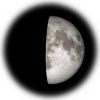Venus will reach half phase in its 2032–2033 evening apparition. It will be shining brightly at mag -4.4.
From South El Monte , this apparition will be well placed and prominent, reaching a peak altitude of 41° above the horizon at sunset on 28 Jan 2033.
2032–2033 evening apparition of Venus
| 02 Jun 2032 | – | Venus at superior solar conjunction |
| 07 Jan 2033 | – | Venus at greatest elongation east |
| 09 Jan 2033 | – | Venus at dichotomy |
| 27 Jan 2033 | – | Venus at highest altitude in evening sky |
| 13 Feb 2033 | – | Venus at greatest brightness |
The table below lists the altitude of Venus at sunset over the course of the apparition. All times are given in South El Monte local time.
| Date | Sun sets at |
Venus sets at |
Altitude at sunset |
Direction at sunset |
Mag | Phase |
| 29 Oct 2032 | 18:00 | 19:58 | 18° | south-west | -4.0 | 77% |
| 08 Nov 2032 | 16:52 | 19:07 | 20° | south-west | -4.1 | 74% |
| 18 Nov 2032 | 16:45 | 19:20 | 23° | south-west | -4.1 | 71% |
| 28 Nov 2032 | 16:42 | 19:36 | 25° | south-west | -4.2 | 68% |
| 08 Dec 2032 | 16:41 | 19:53 | 28° | south-west | -4.2 | 64% |
| 18 Dec 2032 | 16:44 | 20:11 | 32° | south-west | -4.3 | 60% |
| 28 Dec 2032 | 16:50 | 20:26 | 35° | south-west | -4.4 | 56% |
| 07 Jan 2033 | 16:57 | 20:39 | 38° | south-west | -4.4 | 51% |
| 17 Jan 2033 | 17:06 | 20:47 | 40° | south-west | -4.5 | 46% |
| 27 Jan 2033 | 17:16 | 20:51 | 41° | south-west | -4.6 | 39% |
| 06 Feb 2033 | 17:26 | 20:49 | 40° | south-west | -4.6 | 32% |
| 16 Feb 2033 | 17:36 | 20:37 | 36° | west | -4.6 | 24% |
| 26 Feb 2033 | 17:45 | 20:10 | 29° | west | -4.6 | 15% |
| 08 Mar 2033 | 17:53 | 19:25 | 18° | west | -4.4 | 6% |
Altitude of Venus at sunset
A graph of the phase of Venus is available here.
Apparitions of Venus
| 18 Mar 2030 | – | Morning apparition |
| 02 Jun 2031 | – | Evening apparition |
| 21 Oct 2031 | – | Morning apparition |
| 07 Jan 2033 | – | Evening apparition |
| 29 May 2033 | – | Morning apparition |
| 12 Aug 2034 | – | Evening apparition |
| 31 Dec 2034 | – | Morning apparition |
Observing Venus
Venus's orbit lies closer to the Sun than the Earth's, meaning that it always appears close to the Sun and is lost in the Sun's glare much of the time.
It is observable for a few months each time it reaches greatest separation from the Sun – moments referred to as greatest elongation. These apparitions repeat roughly once every 1.6 years.
On these occasions, Venus is so bright and conspicuous that it becomes the third brightest object in the sky after the Sun and Moon. It is often called the morning star or the evening star.
Venus's phase
Venus's phase varies depending on its position relative to the Earth. When it passes between the Earth and Sun, for example, the side that is turned towards the Earth is entirely unilluminated, like a new moon.
Conversely, when it lies opposite to the Earth in its orbit, passing almost behind the Sun, it appears fully illuminated, like a full moon. However, at this time it is also at its most distant from the Earth, so it is actually fainter than at other times.
Venus shows an intermediate half phase – called dichotomy – at roughly the same moment that it appears furthest from the Sun, at greatest elongation. The exact times of the two events may differ by a few days, only because Venus's orbit is not quite perfectly aligned with the ecliptic.
Venus's position
The coordinates of Venus when it reaches dichotomy will be:
| Object | Right Ascension | Declination | Constellation | Angular Size |
| Venus | 22h33m20s | 9°46'S | Aquarius | 25.0" |
| Sun | 19h23m | 22°03'S | Sagittarius | 32'31" |
The coordinates above are given in J2000.0.
The sky on 9 Jan 2033
| The sky on 9 January 2033 | ||||||||||||||||||||||||||||||||||
|
71% 8 days old |
All times shown in PST.
|
|||||||||||||||||||||||||||||||||
Source
The circumstances of this event were computed using the DE430 planetary ephemeris published by the Jet Propulsion Laboratory (JPL).
This event was automatically generated by searching the ephemeris for planetary alignments which are of interest to amateur astronomers, and the text above was generated based on an estimate of your location.
Related news
| 07 Jan 2033 | – Venus at greatest elongation east |
| 28 Jan 2033 | – Venus at highest altitude in evening sky |
| 29 May 2033 | – Venus at greatest elongation west |
| 25 Jul 2033 | – Venus at highest altitude in morning sky |
Image credit
© NASA/Ricardo Nunes


